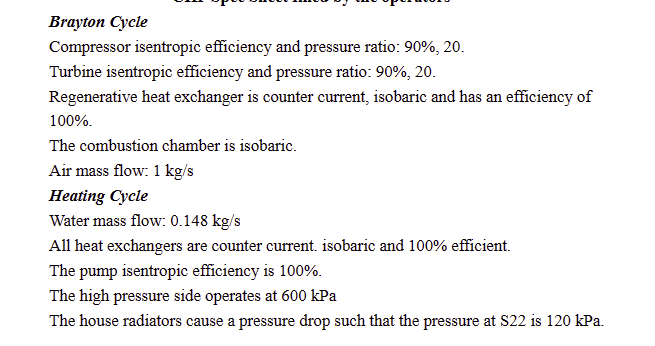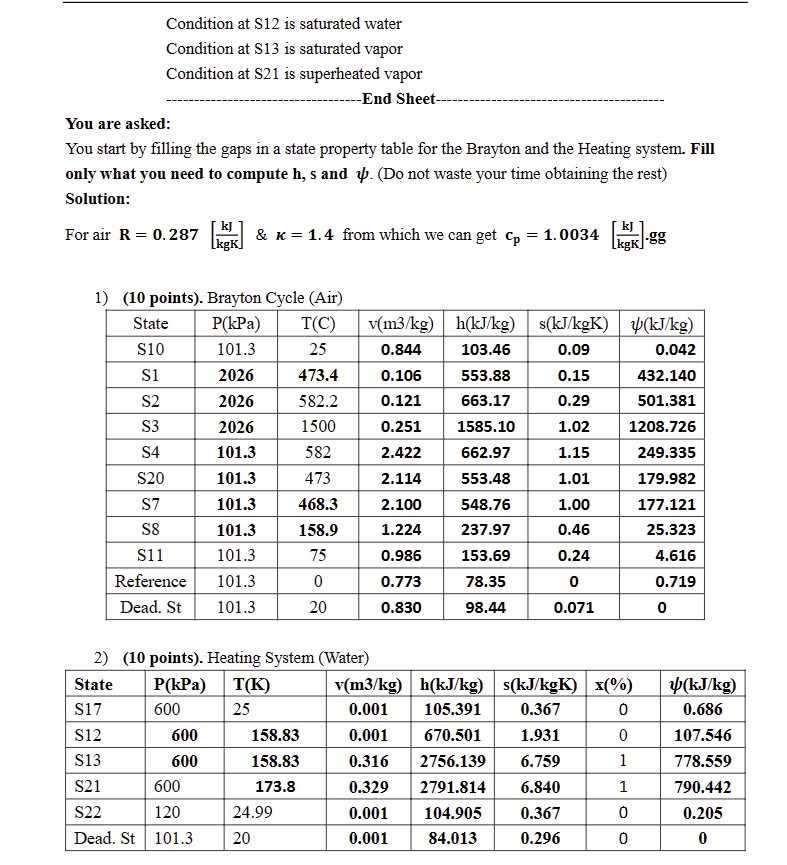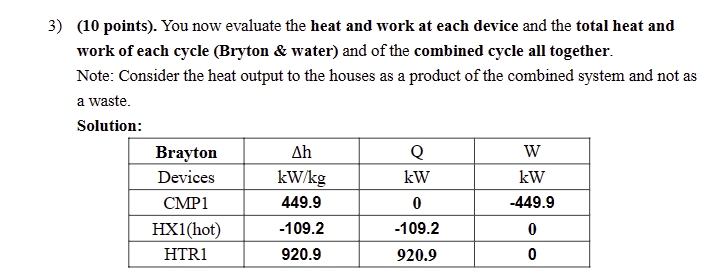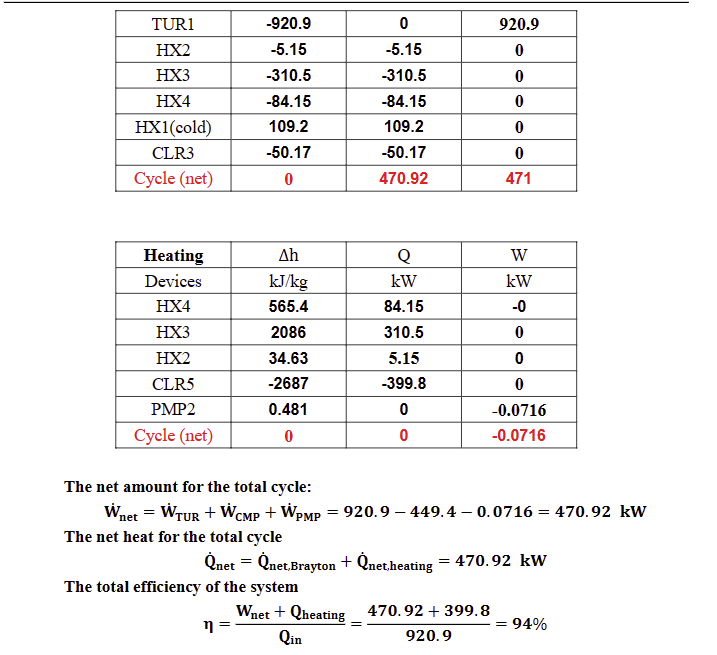Answered step by step
Verified Expert Solution
Question
1 Approved Answer
A Combined Heat and Power (CHP) system consist of a gas turbine running under a regenerative Brayton cycle and a heat recovery steam generator





A Combined Heat and Power (CHP) system consist of a gas turbine running under a regenerative Brayton cycle and a heat recovery steam generator that supplies steam to a residential district. When it first was build, the system was designed to provide 470 KWe to the grid and 2kW per house of heating to a district of 200 houses that normally remain at 25 C. Now, the area has grown and more heating is required. As an engineer you are required to evaluate the system and propose a solution. Your first step is to evaluate the current system to recognize room for improvement. To do so, you realize a thermodynamic analysis of the system with the information you are supplied from the operator which do not know much apart from the reading on some gauges next to the equipment. CMP1 5 $1 S21 S20 11X1 CLR5 HX2 32 B IITR1 A S7 S13 A $10 S22 S1 G3 HX3 B A S12 TUR1 PMP2 S8 B $17 HX4 S11 CLR3 Brayton Cycle Compressor isentropic efficiency and pressure ratio: 90%, 20. Turbine isentropic efficiency and pressure ratio: 90%, 20. Regenerative heat exchanger is counter current, isobaric and has an efficiency of 100%. The combustion chamber is isobaric. Air mass flow: 1 kg/s Heating Cycle Water mass flow: 0.148 kg/s All heat exchangers are counter current. isobaric and 100% efficient. The pump isentropic efficiency is 100%. The high pressure side operates at 600 kPa The house radiators cause a pressure drop such that the pressure at S22 is 120 kPa. Condition at $12 is saturated water Condition at S13 is saturated vapor Condition at S21 is superheated vapor --End Sheet- You are asked: You start by filling the gaps in a state property table for the Brayton and the Heating system. Fill only what you need to compute h, s and . (Do not waste your time obtaining the rest) Solution: For air R = 0.287 kJ [kgk] 1) (10 points). Brayton Cycle (Air) State P(kPa) T(C) $10 101.3 25 S1 2026 473.4 S2 2026 582.2 S3 2026 1500 S4 101.3 582 S20 101.3 473 S7 101.3 468.3 S8 101.3 158.9 $11 101.3 75 Reference 101.3 0 Dead. St 101.3 20 600 600 & K = 1.4 from which we can get Cp = 1.0034 $12 S13 S21 600 S22 120 Dead. St 101.3 2) (10 points). Heating System (Water) State P(kPa) T(K) $17 600 25 158.83 158.83 173.8 24.99 20 v(m3/kg) h(kJ/kg) s(kJ/kgK) (kJ/kg) 0.844 103.46 0.09 0.042 0.106 553.88 0.121 663.17 0.251 1585.10 2.422 662.97 2.114 553.48 2.100 548.76 1.224 237.97 0.986 153.69 0.773 78.35 0.830 98.44 kJ [kgk 0.15 0.29 1.02 1.15 1.01 1.00 0.46 0.24 0 0.071 432.140 501.381 1208.726 249.335 179.982 177.121 25.323 4.616 0.719 0 v(m3/kg) h(kJ/kg) s(kJ/kgK) x(%) 0.001 105.391 0.367 0 0.001 670.501 1.931 0.316 2756.139 6.759 0.329 2791.814 6.840 0.001 104.905 0.367 0.001 84.013 0.296 0 1 1 0 0 (kJ/kg) 0.686 107.546 778.559 790.442 0.205 0 3) (10 points). You now evaluate the heat and work at each device and the total heat and work of each cycle (Bryton & water) and of the combined cycle all together. Note: Consider the heat output to the houses as a product of the combined system and not as a waste. Solution: Brayton Devices CMP1 HX1 (hot) HTR1 kW/kg 449.9 -109.2 920.9 Q kW 0 -109.2 920.9 W kW -449.9 0 0 TUR1 HX2 HX3 HX4 HX1(cold) CLR3 Cycle (net) Heating Devices HX4 HX3 HX2 CLR5 PMP2 Cycle (net) -920.9 -5.15 -310.5 -84.15 109.2 -50.17 0 kJ/kg 565.4 2086 34.63 -2687 0.481 0 0 -5.15 -310.5 The total efficiency of the system n= -84.15 109.2 -50.17 470.92 Wnet + Qheating Qin Q kW 84.15 310.5 5.15 -399.8 0 0 920.9 0 0 0 0 0 471 The net amount for the total cycle: Wnet = WTUR + WCMP + WPMP = 920.9-449.4 -0.0716 = 470.92 kW The net heat for the total cycle 470.92 + 399.8 920.9 W kW -0 0 0 0 -0.0716 -0.0716 Qnet = Qnet,Brayton + Qnet.heating = 470.92 kW = 94%
Step by Step Solution
There are 3 Steps involved in it
Step: 1
To determine the number of teeth on all the wheels and the exact pitch circle diameter of A we can f...
Get Instant Access to Expert-Tailored Solutions
See step-by-step solutions with expert insights and AI powered tools for academic success
Step: 2

Step: 3

Ace Your Homework with AI
Get the answers you need in no time with our AI-driven, step-by-step assistance
Get Started


